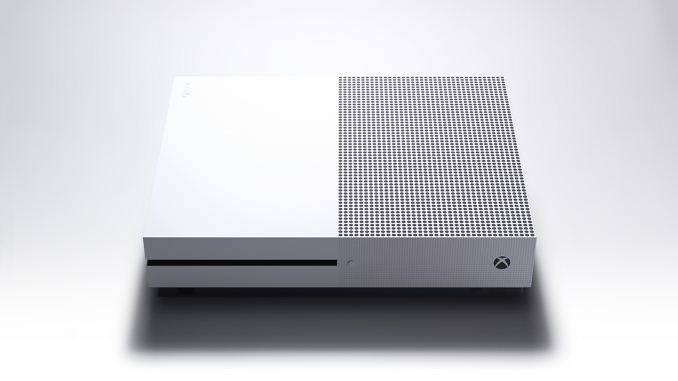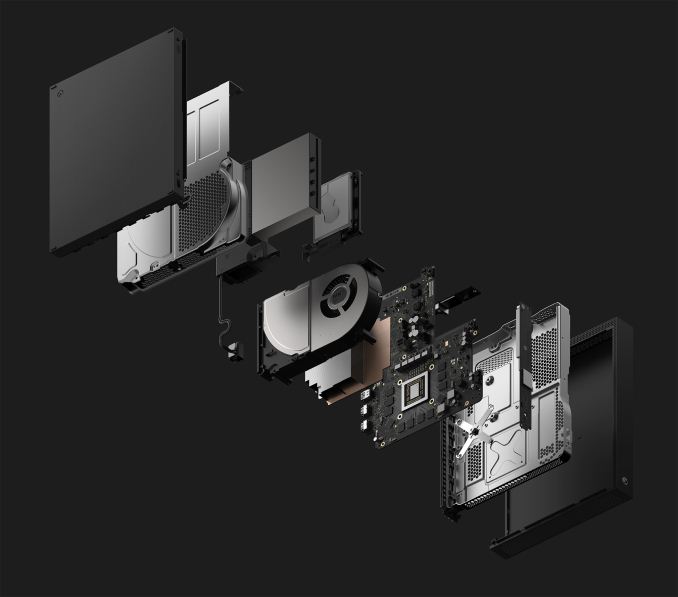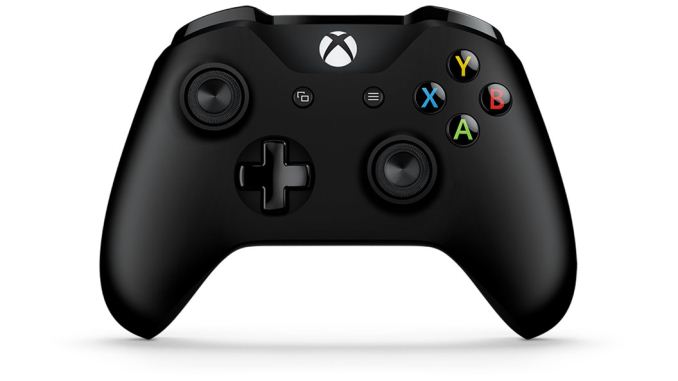The Xbox One X Review: Putting A Spotlight On Gaming
by Brett Howse on November 3, 2017 3:01 AM EST- Posted in
- Consoles
- Microsoft
- Xbox One
- Xbox
- Xbox One X
The Xbox One X Design
Small. Sleek. Refined. All are words that can easily describe the latest Xbox console. Despite having almost five times the performance of the original, the new console is only 60% of the volume of the Xbox One. And that’s before you factor in the Xbox One X has a built-in power supply, while the original had a huge external power brick. Clearly Microsoft is pretty happy with the design of the Xbox One S, because the new console takes most of its styling cues from the mid-cycle refresh of the original Xbox One, except they’ve moved back to black. The black certainly blends in better with A/V equipment, so it should please most people. Without doubt, there will be special editions of the console later with all sorts of color options. Maybe Microsoft should just add the Xbox itself to the Xbox Design Labs so you can create your own?
Picking up the Xbox One X, it feels incredibly dense. The new console is less than 300 grams heavier than the original, but the smaller chassis makes it feel even heavier.
 Evolving the design of the Xbox One S
Evolving the design of the Xbox One S
The front design is very sleek. Like the Xbox One S, Microsoft has ditched the capacitive power button and gone with a much better feeling physical switch. The USB port is now on the front, as well as the controller pairing button, and the disc drive and eject button are on the left. It really does look great, and it feels like a solidly built device, despite that fact that the importance of materials and design isn’t as necessary as it would be on a device you carry with you.
The only small quibble with the design is that all of the buttons, other than the Xbox power button, are color matched to the console, making them difficult to see in a dim TV room. Plus, the UHD Blu-Ray drive slot is also hidden, which aesthetically looks great, but does kind of make you fumble a bit with where to put the disc in, although certainly that will get more familiar over time. This can be compounded if the Xbox One X is mounted low on a shelf under the TV. If that's the case, looking down at the console, the overhang of the top obscures the buttons and USB ports.
The back features the HDMI input and output ports, so Microsoft has kept the TV input capabilities intact. There’s also two USB 3.0 Type-A ports, along with S/PDIF, Ethernet, and an IR output, which would need to be paired with an IR cable if you want the Xbox to control your TV or cable box.
The back of the device gives a hint at what’s inside. Cooling is one of the most important aspects to the design of the Xbox One X, and not only for product longevity. No one wants a loud cooling system. The original Xbox One was decent in this regard, but was definitely audible, even across the room. Despite the increased performance, and smaller chassis, the Xbox One X is practically silent, even at load.
At idle, with a SPL meter about 6-inches in front of the Xbox One X, the SPL reading was just around 38 dB(A). Considering the 36 dB(A) sound floor in the room, that’s pretty good. It’s not silent, but across the room, it’s practically silent. Under the load of Gears of War 4, which is a 4K title, the Xbox One X only went up to 41 dB(A) which is fantastic.
The move to put the power supply inside the console also adds to the thermal load that the Xbox One X has to deal with, compared to the original where the power supply was an external brick attached to the power cord. But the benefits to the user are a much neater package, without having to deal with finding a place to hide the power supply. In the case of the Xbox One X, Microsoft has outfitted it with a 245-Watt universal voltage PSU, and the company claims it is the most efficient ever put into an Xbox. Also thanks to the internal power supply, the power cable itself is a standard cable as well, compared to the much larger cable on the original, since it won’t need to carry as many amps with the higher input voltage of a power outlet feeding directly into the console.
The Controller: Standard and Custom
The Xbox One X ships with the new standard Xbox controller. There’s a few changes from the launch device, but the overall design is very similar. The latest generation of controller from Microsoft incorporates a 3.5mm headset jack into the bottom of the controller, rather than requiring a proprietary headset connector. This alone is a big update. The other major change is that the new controllers also support Bluetooth, for connecting to PCs, in addition to the Wi-Fi Direct connection the controller still uses for connections to the Xbox and select PCs with Xbox Wireless built-in.
The top of the controller has been subtly changed as well, with the front face now enclosing the Xbox button at the top, rather than having it somewhat separated as it was when the console first launched. It’s a small styling cue, but it’s also an easy way to tell if your controller is the updated model offering Bluetooth.
It’s still powered by two AA batteries, although you can purchase the Play & Charge Kit, or third-party solutions as well, if you want a rechargeable solution.
As previously mentioned, Microsoft has really upped their game in terms of controllers, even though the standard model that comes with the Xbox One X hasn’t changed dramatically from the launch version.
First, you can visit the Xbox Design Lab to create your own controller. You can pick the body, back, bumpers, triggers, D-Pad, ABXY, and menu buttons from an array of colors and styles, including rubberized hand grips, and metallic triggers. You can also get it engraved with up to 16 characters, if you want to put your gamertag on the controller. It may sound a bit gimmicky to some, but it starts at just $20 more than the standard controller, and can be a great way to create an attachment between the device and the owner. If you're into the NFL, Xbox Design Labs now lets you add your team logo to your controller.
If you don’t want to design your own, Microsoft also offers a wide array of custom controller colors, including some with some very cool shadow effects.
Finally, Microsoft offers the Xbox One Elite Controller. Yes, it does have a $149.99 MSRP, but it has a very solid feel, on top of the interchangeable components included with it. It comes with three sets of thumb sticks, two D-pads, and rear paddles that can be mapped to any button. There’s hair-trigger locks for the triggers themselves, an app to customize it all, and a very nice carrying case for the controller and all of its accessories. If you’re an Xbox fan, and you haven’t tried this controller out, you should.
The Xbox One controller design has held up pretty well, and it’s great to see small tweaks to it over the years to make it even better. If you want something other than the included standard black model though, there’s plenty of first-party options.

















128 Comments
View All Comments
Manch - Friday, November 3, 2017 - link
explain?StevoLincolnite - Friday, November 3, 2017 - link
12 memory chips with each memory chip having it's own 32bit memory controller for a 384bit memory bus.There are only 32 ROPS.
Which means there is an additional memory crossbar just like the Radeon 7970... Which also means that there could be scenario's where real-world bandwidth ends up as 218GB/s rather than the full 326GB/s.
StevoLincolnite - Friday, November 3, 2017 - link
Ian elaborated upon that in a prior article. I just thought it might have been expanded upon here.Manch - Friday, November 3, 2017 - link
Ah OK, thanks for explaining.What would be a typical scenario that would cause this? Or is there a link or google phrase that will pull up the relevant info.
Appreciate it.
Ryan Smith - Friday, November 3, 2017 - link
Unfortunately I don't have any new information to add on the subject at this time. But I wouldn't draw too many comparisons to Tahiti; the situation is made a lot more complex by the fact that a CPU is being fed as well (which is also why even the original XB1 had the equivalent of a memory crossbar).StevoLincolnite - Saturday, November 4, 2017 - link
Fair call. Microsoft stated it was able to achieve 285GB/s of bandwidth out of 326GB/s.But they didn't really elaborate beyond that.
http://www.tomshardware.com/news/xbox-scorpio-engi...
Manch - Saturday, November 4, 2017 - link
Interesting, and thanks for the link. I've been reading up on the 7970(what I can find) and now Ill have to add this to the list.alistair.brogan - Friday, November 3, 2017 - link
Not a single game made expressly for this console. Kind of weird right? I'd rather the n64 situation with 2 launch games!!!Would have loved to see a 1080p/60fps game made only for the X. Guess I'm waiting for a PS5 now.
Manch - Friday, November 3, 2017 - link
That comment makes no sense. If you're not trolling, utilize the power of the internet and read up.TEAMSWITCHER - Friday, November 3, 2017 - link
Games ... yes. Great Games ... Not so much. The Nintendo switch has two new perennial favorite titles (Zelda Breath of the Wild + Super Mario Odyssey) each with a Metacritic Score of 97!! Where are these critically acclaimed titles on the XBox and PS4? Even the PC seems to suffer from a lack of ground breaking titles. Non-Nintendo gaming needs to bring the ground breaking titles ... otherwise what's the point?